
1Q KŪPONO WINNERS NETWORK PLANNING 2.0 CELEBRATING WĀHINE CAREER AMBASSADORS APRIL 2023 OUR PATH TO SUSTAINABILITY 2020 2025 2030 2035 2040 2045 2030 Replace 10% of our jet fuel with SAF Projected base case emissions Target emissions pathway 2035 Reduce emissions intensity by10% Net-zero by 2050 9% Fleet renewal 3% Operational efficiencies 4% Air traffic control modernization 10% Next-generation aircraft 64% Sustainable aviation fuel (SAF) 10% Offsets Updated March 2023.Subject to change as underlying assumptions evolve.
course, but the challenging work goes easier with the positive tone set by Aircraft Mechanic Daniel Basques. It helps that his attention to detail and excellence encourages his teammates to do the same. “He clearly communicates this vision and inspires us all to follow his lead,” said his nominator, Aircraft Mechanic Christopher Rake. “His wide range of knowledge and easygoing attitude is a joy to be around, especially in a demanding
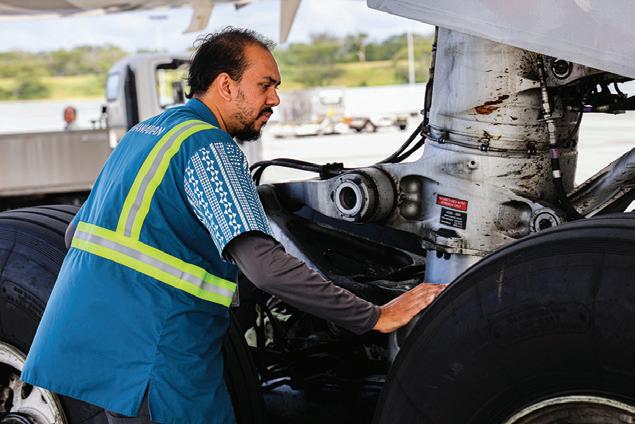
have. There isn’t a time recently where I can recall Kanani not knowing an answer, but in those rare instances, she makes sure you get the answer you
deliverance of knowledge is top tier and doesn’t go unnoticed.”
KANANI KEALOHA-FALEAFINE / Our Amadeus Passenger Service System (PSS) transition this month has brought the best out of a lot of teammates, including Senior Manager, Loyalty, Kanani Kealoha-Faleafine, who has built upon her reputation as a go-to problem-solver and knowledgable company resource. “I have never officially been assigned to a project with her. However, there have been many instances where I’ve seen her step into a problem, take the lead and drive the group to a resolution,” said her nominator, Loyalty Marketing Specialist Tori Tokunaga. “She is more than willing to share valuable and meaningful Hawaiian Airlines knowledge that not many

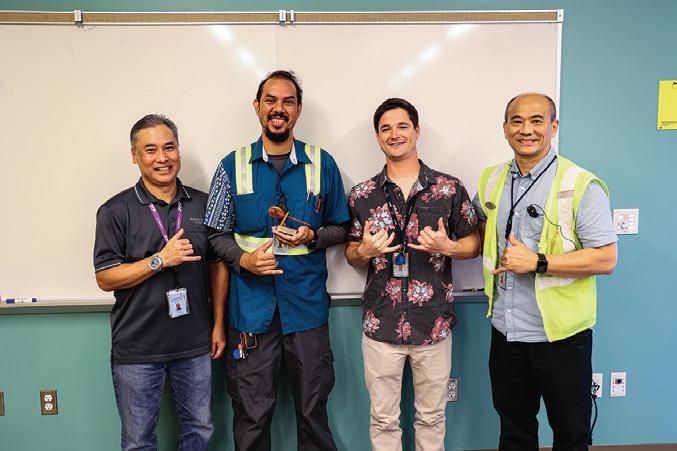
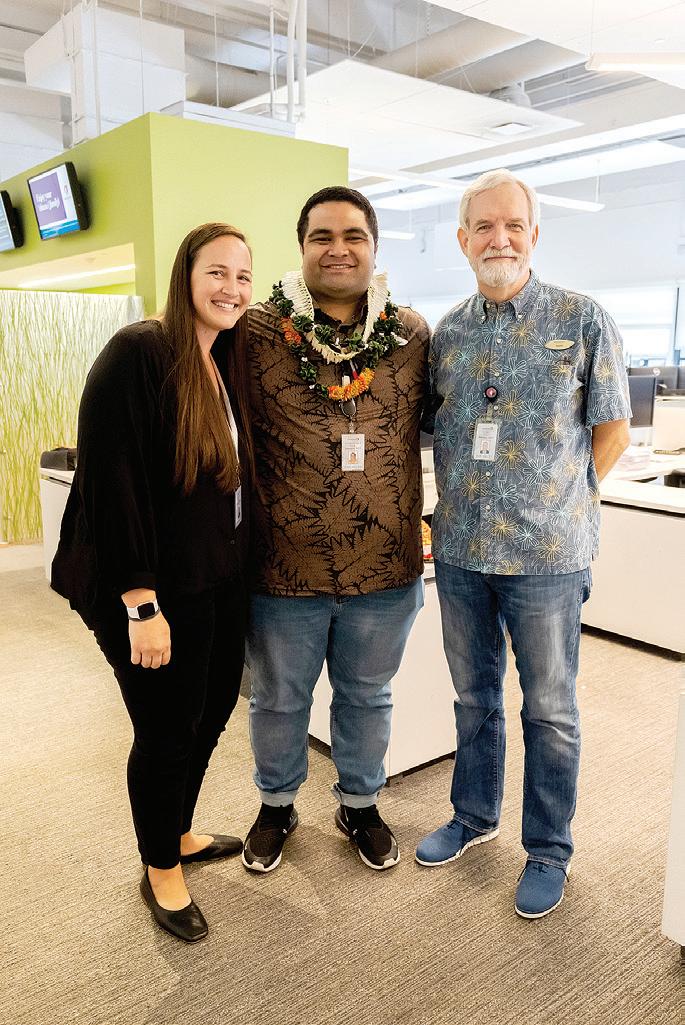

1Q Kūpono Awards
“I have worked in several departments in my almost five years with Hawaiian Airlines and I can honestly say that Keenan is the most caring manager I have had,” noted Crew Scheduler Brooke Soon. “He goes above and beyond for Hawaiian Airlines and is a true example of Po’okela. We are blessed to have him as a leader in the Crew Scheduling department.” ■

In addition, Sean exhibits care, knowledge and thoroughness in ensuring the safety of our fleet and guests, builds cohesion with his hospitality and helpfulness, and seeks many perspectives to grow the team’s knowledge. “Sean is always willing to put in the extra time and effort in order to make everyone’s job here in SMF easier,” Alexander said. “He displays selflessness, knowledge, and the most dedicated work ethic I’ve ever observed — all with a smile on his face.” ■
TRACY FREITAS / LEADER OF THE QUARTER / In a distributed operation, communication and connection can be challenging, but for Regional Manager of Neighbor Islands Cargo Operations Tracy Freitas, it’s a challenge she routinely faces and conquers. She recognized that her team needed more opportunities for open communication and feedback, so at the end of 2021 began facilitating twice-monthly roundtables where teammates could call in to share thoughts, concerns and suggestions, hosting station managers and their regulatory manager to provide important updates.
“What sets Tracy apart is her genuine care and openness to listen and respond to feedback,” said Director of HNL Cargo Operations Keoni Kauhane, who noted that her success with that effort inspired others on her leadership team to bring it to HNL Cargo this year. She is often tracking down information to ensure her team’s questions are answered, but she’s also in the operation sharing food and thanking everyone for their

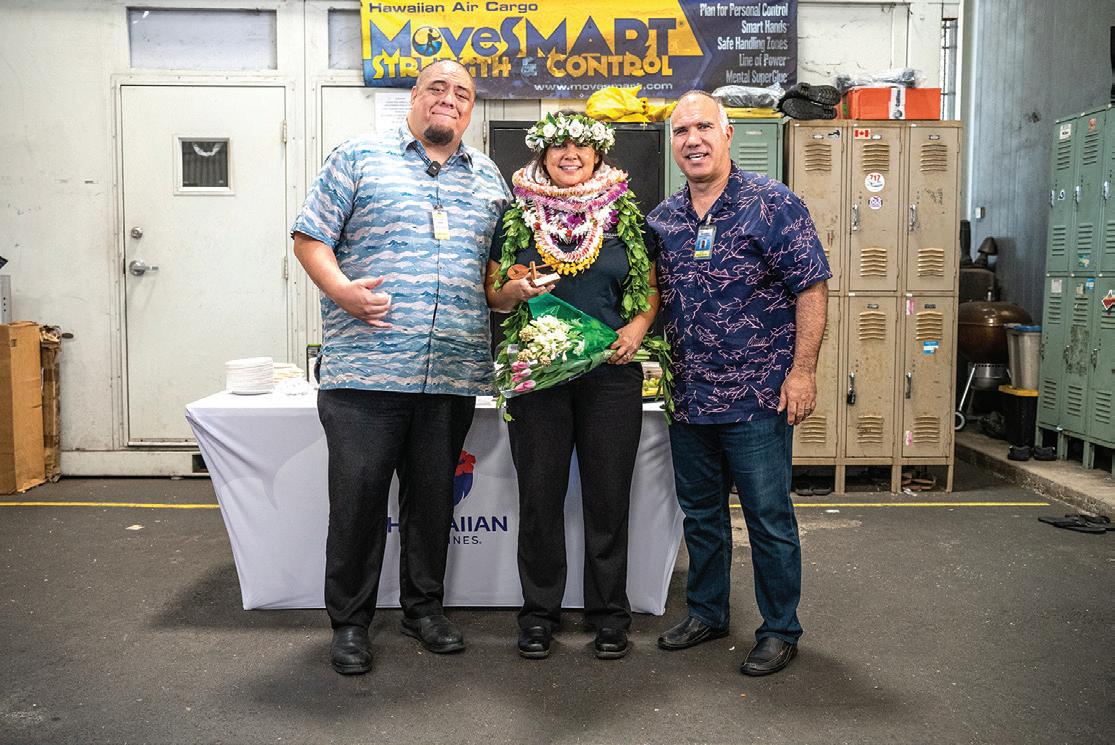


Our March Toward Balance
Last month, we released our Sustainability Roadmap to demonstrate how we plan to achieve net-zero greenhouse gas (GHG) emissions by 2050. Alanna James, Managing Director of Sustainability Initiatives, is shepherding the plan and provided an overview of our work to reach our goal.

Sustainable Aviation Fuel (SAF)
Carbon reduction contribution: 64%
SAF is made from sustainable feedstock and works with today’s aircraft engines when blended up to 50% with conventional jet fuel. In addition forming our partnership last month with Par Hawaii to study the commercial viability of SAF production, we announced a deal with Gevo, Inc. to purchase 50 million gallons of SAF over five years, with deliveries to our California gateways beginning in 2029. As you can see in the roadmap (see cover), SAF is expected to be our biggest decarbonization driver. We have committed to replacing 10% of our jet fuel with SAF by 2030, and we expect to rely heavily on SAF to achieve our 2035 emissions intensity and 2050 net zero goals. The great thing about SAF is that it can be used with existing airplanes and infrastructure, but the challenges are supply and economics — the cost of production is 2 to 5 times that of conventional jet fuel, and therefore will require collaboration across airlines, producers, and state and federal governments. Entering into long-term offtake agreements for future supply, such as our agreement with Gevo, is a way that airlines can help demonstrate the demand signal needed to attract investment into SAF. Over time, with scale and optimization, we expect the cost will become competitive and not require subsidy.
And we are still pursuing the viability of local SAF production with Par Hawaii. The agreement includes an engineering study to evaluate the feasibility of converting a portion of Par’s existing refinery infrastructure to produce SAF, an exploration of the potential to grow oil-yielding crops as well as import sustainable feedstock, and an analysis of which incentive mechanisms could work best to advance SAF in Hawai‘i.
Next-Generation Aircraft
Carbon reduction contribution: 10%
Among the Neighbor Islands, all-electric options like those we’re exploring with REGENT and other start-ups show some promise. But, to make a real impact we will need to see advancements in airframe technology for long-haul aircraft that are at least another 20 years out. Alternative propulsion technologies — such as battery-electric and hydrogen — are exciting opportunities, but they will take time to develop while adhering to safety. In our roadmap, we see next-gen aircraft technologies becoming viable in 2040 for our inter-island routes. Our unique network of short flights within these islands could be a good platform for these emerging technologies once they advance to carry 100+ passengers per flight. Neighbor Island routes only comprise about 10% of our jet fuel consumption,
however. To reduce our carbon footprint, we will need to see advance-ments in aircraft technology that can impact our longhaul routes. Based on industry forecasts, we do not expect to see these before 2050, but our roadmap does contemplate some steps forward in the late 2040s.
Fleet Renewal
Carbon reduction contribution: 9%
We reap some benefit by having one of the youngest longhaul fleets in the industry, and we’ll realize some additional efficiencies when we add our Boeing 787s. We’ve invested heavily in fleet renewal over the past decade, so we are reaping that benefit now. We will see some additional benefit from our Boeing 787s as they’re added. We are targeting, by 2028, a 4% improvement in fuel efficiency per ASM compared to 2019.
Air Traffic Control (ATC) Modernization
Carbon reduction contribution: 4%
This federal effort aims to improve several issues with the nation’s air traffic system, but the airline industry should benefit from more efficient routing of aircraft. While this is not a Hawaiian Airlines initiative, we wanted to include ATC modernization in our roadmap as it is an important federal initiative to improve our country’s air traffic control system and it should help all airlines operating in US airspace to conserve fuel. However, as we operate in fewer congested airports as compared with our peers, this is likely to be a smaller opportunity for us.
Operational Efficiencies
Carbon reduction contribution: 3%
Each year, we find several incremental adjustments in the operation with small yields that together add up to important savings — examples include single-engine taxi and minimizing over-fueling. Our operating teams have been working together on fuel efficiency initiatives for many years with good results. To help track our progress, we have established a target to conserve 3 million gallons of fuel through these initiatives by 2028.
Carbon Offsets
Carbon reduction contribution: 10%
As our 2050 target approaches, we’ll consider using offsets to drive down any remaining balance. Our preference is to focus our efforts and investments on in-sector GHG reduction measures, such as SAF and fuel efficiency, to achieve our sustainability goals. However, we recognize that our roadmap relies heavily on technologies that don’t exist today, and we may need to use carbon offsets or removals to close any gaps. ■
4
Network Planning Flexibility
It has often been said that recovery would not be a straight line, and we’ve had to adapt to changing market conditions that have defied predictions. Our Network Planning team has been at the forefront of adjustments to keep our aircraft flying full in highly competitive skies. Managing Director of Network and Schedule Planning Bob Westgate took time away from his “instruments” to share insight on his team’s work.
What strategies does the Network Planning team use as we attempt to complete our rebuild? Our focus has had to shift from 18-month and 5-year plans to the more immediate term as we return our network towards prepandemic levels. Along the way, we have added service in new markets; for example: HNL-AUS, HNL-ONT, and OGG-LGB. We are finally starting to shift back to a longerterm focus and look forward to planning increased and new service, along with welcoming the Boeing 787 to our network.
What’s happening in our Japan market? We look forward to the day when our guests from Japan resume travel to Hawai‘i closer to pre-pandemic levels. At the moment, these guests are facing some “headwinds” that are constraining a return to “normal,” including an unfavorable exchange rate and higher (lodging & food) costs here in the Islands. At the same time, the Government of Japan continues to incent their citizens to fly and buy domestically, and they have in place a program that encourages this — at least through the end of May. No one knows when travel from Japan to Hawai‘i will return to normal, but we continue to adjust our plans to reflect the current reality while, at the same time, constructing plans that have some degree of flexibility should a sudden return to more normal traffic levels materialize.
How are we adjusting the way we use the aircraft, so they can keep flying and bringing in revenue? We would normally be operating six A330 aircraft per day between Hawai‘i and Japan, but have had to reduce this to three: six weekly flights on our key routes between HNL and HND, KIX, and NRT along with thrice-weekly service on our FUK route beginning April 28. The three surplus aircraft have been used to upgauge some U.S. West Coast routes, freeing up the A321neo aircraft to open new services, including HNL-ONT and OGG-LGB. This is not ideal as we would prefer to operate these thinner West Coast routes on the A321. Fortunately, these routes do
HNL-LAX roundtrip on select days of the week.




What factors do we consider in deciding whether to add a new gateway or increase frequency on an existing route? We are constantly monitoring the health of our network and we continue to analyze market and competitive actions and trends. Through this process, we identify opportunities and options for network expansion or rationalization. We evaluate potential new routes and assess their viability by compiling traffic and P&L (profit and loss) forecasts.
It has been suggested that we try flying between points in the continental U.S. What’s stopping us from doing so? We’ve looked at intra-mainland flying and won’t rule it out. For us to succeed there, we would need to have a long-term competitive advantage, either in terms of cost or revenue generating capabilities. Continuing flights past our West Coast gateways is problematic as most of our aircraft maintenance is performed at these locations. Finally, it would stretch our crew resources, given that much of our West Coast flying is based on two-day pairings (Day 1 - Hawai‘i to West Coast; Day 2 - West Coast to Hawai‘i). ■
5
Back with the Warriors
In Hawai‘i, you can always go home again, especially if you have good career tips. Last month, Chief Financial Officer Shannon Okinaka returned to her alma mater, Waiākea High School in Hilo, accompanied by Senior Director of Brand and Community Alisa Onishi, and our Career Ambassadors coordinator, Senior Manager of Talent Acquisition, Programs & Innovation, Jadyne Yomono.

STUDENTS IN WAI Ā KEA’S Academy of Industry nd Technology learned more about Hawaiian Airlines’ economic and community impact, its brand evolution and competition — along with what it takes to thrive in a career.



“There is no ‘one way’ to my career or any career — it’s an accumulation of education, experience and being open to new things,” Shannon said. “The most important thing is working hard and bringing your best every day. That will open doors.” A good idea, she shared, is to recognize when a job isn’t working for you — it’s why she left one early in her career, which led to the accounting firm where Hawaiian was a client, which led to an offer to join HA in 2005.
During the Q&A, students asked about how we pay for major assets like aircraft, pick new routes, and manage risk. Sharing some of the baseline strategies behind that work, Shannon noted, “Airlines are a very complex business. But I’m happy to
teach ‘airline’ to anyone who’s eager to learn — we all want to pass on what we know so our company thrives.”
While there are many challenges and struggles in any career path, Shannon said it’s the employees who make it worthwhile. “I get to work with great people every day.”
Our Career Ambassadors team is comprised of trained volunteers who speak on behalf of Hawaiian Airlines on career pathways and opportunities. Learn more on HApeople
 Photos, left to right: Jadyne warms up the class with an overview of Hawaiian Airlines, Shannon shares how Hawaiian Airlines brings value to the state, and Shannon is reunited
Alisa and Shannon talk story with Waiākea teachers and students between sessions.
Shannon, at left, at her high school graduation.
Photos, left to right: Jadyne warms up the class with an overview of Hawaiian Airlines, Shannon shares how Hawaiian Airlines brings value to the state, and Shannon is reunited
Alisa and Shannon talk story with Waiākea teachers and students between sessions.
Shannon, at left, at her high school graduation.
Celebrating our Wāhine

“It really is a credit to those trailblazers who paved the way to be the first ones to break into professions that have historically been male dominated. It’s our responsibility as leaders to make sure we’re enabling that. We benefit as a business in the end from having that diversity in our team.”


 Peter Ingram President & CEO
Peter Ingram President & CEO
“It’s inspirational for kids to see moms out there as women leaders moving up the chain — working full time and taking care of the kids.”
Eli Oki Director, Ops Support Engineering
in Long Beach, Calif. with lei.
“I have a strong faith in this company’s importance in the community; it’s about the survival of a business that supports a lot of families here.”
Robin Kobayashi SVP of Human Resources

let anyone tell you otherwise. I carried her advice with me over the years, and it’s led me to an enriching career in dispatch that I hope more women consider.”
 Chelsea Chong Dispatcher
Chelsea Chong Dispatcher
 Eli Oki, Director, Ops Support Engineering, interviews President & CEO Peter Ingram at the Charles I. Elliott Hangar & Maintenance Facility.
Eli Oki, Director, Ops Support Engineering, interviews President & CEO Peter Ingram at the Charles I. Elliott Hangar & Maintenance Facility.
Mahalo i nā lālā he 3,000 mai loko mai o nā ke‘ena like ‘ole o ka Hui Wa‘alele ‘o Hawaiian i alu like mai i ka hana no ka ne‘e ‘ana i ke kahua o Amadeus Altea. Ua ku‘upau i ka hana no nā hola he nui – i loko nō o ka lawelawe ‘ana i nā hana ma‘amau – i mea e kīpapa ai i ke ala mālamalama no kēia mua aku. He mau ālaina nō i kupu a‘ela i kēia ne‘e ‘ana me ka hō‘e‘e ‘ōhua ‘ana a me ka ho‘opa‘a likiki ‘ana kekahi i ka ‘ā hou ‘ana mai o ka ‘ōnaehana, ‘a‘ole na‘e i pū‘iwa ‘oiai he huliau kēia no kākou. Mahalo nui i nā ‘Ākena Ho‘okipa a me nā lālā o Team Kōkua na lākou i alaka‘i aku i nā ‘ōhua i loko o ke kahua mokulele me ka mākaukau a akamai ho‘i. Mahalo pū iā kākou pākahi a pau i ka ho‘omanawanui a me ke ‘ano polopeka mau i loko o kēia wā hana nui. I ka ho‘okō piha ‘ana o kēia ‘ōnaehana ‘ōhua, e ‘oi aku ana ka ma‘alahi o ka ho‘ohana ‘ana a me ka mālama ‘ana ma mua o ka ‘ōnaehana mua, a e nui hou aku ana nā mea hiki. He hana nui koe, akā no kēia lā, ke ho‘omaika‘i aku nei iā ‘oe i ke kāko‘o piha ‘ana a i ka pae pono ‘ana i kēia.
Mahalo to our more than 3,000 teammates representing several departments at Hawaiian Airlines who played a key role in our transition to the Amadeus Altea platform. You have dedicated many hours — often in addition to your regular day-to-day duties — to prepare us for a bright future. No transition of this scale goes perfectly, and we had challenges with check-in and booking as our systems came back online. We appreciate our Guest Service Agents and Team Kōkua volunteers for moving our guests through our airports as efficiently as possible, and mahalo everyone for your patience and professionalism. At full strength, our new passenger service system will be easier to maintain and use and allow us to diversify our product offerings. There is more to do, but for now, we thank you for helping us reach this milestone. ■
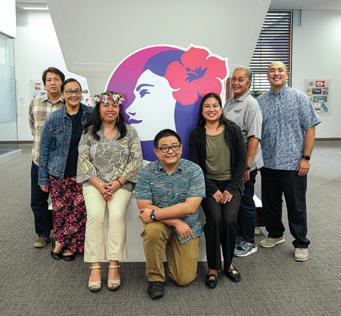


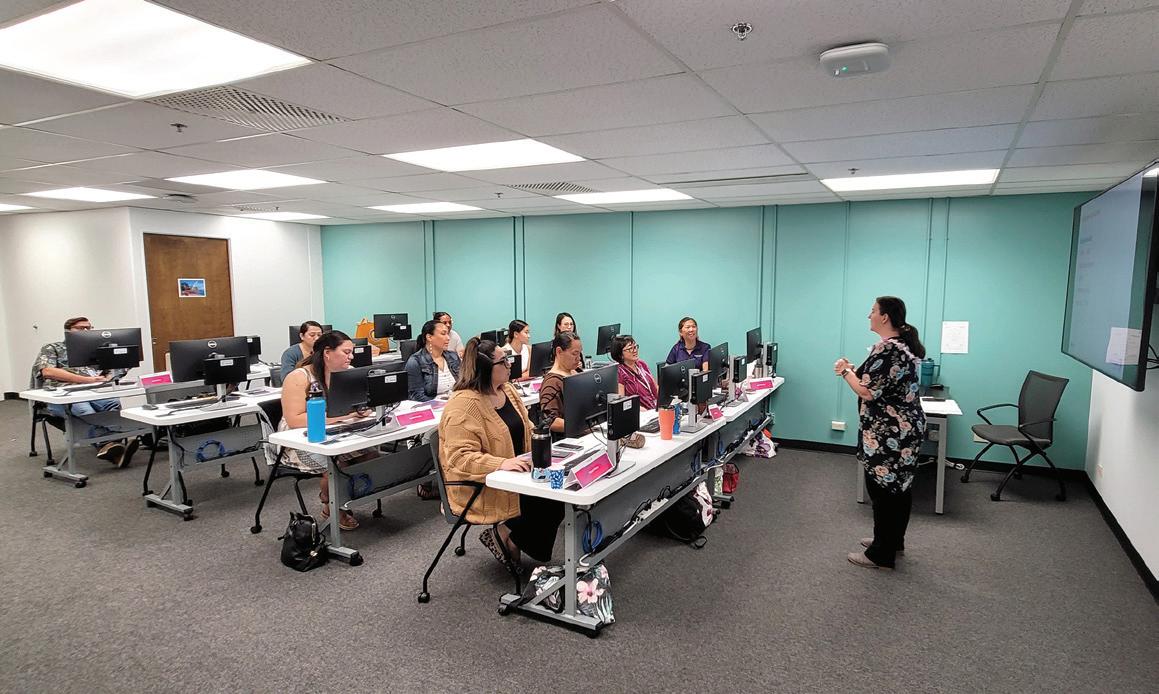

Please direct any comments or suggestions to HA.Corporate Communications@HawaiianAir.com.
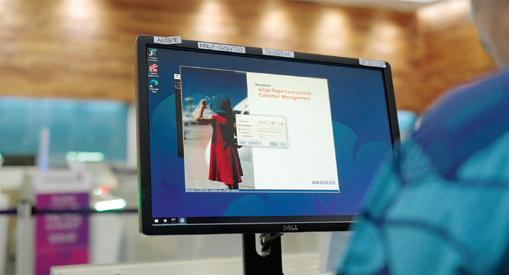


8
is published monthly by the Internal Communications team.
issues, get the latest information at HApeople.com
Hō‘ike
Between





















 Photos, left to right: Jadyne warms up the class with an overview of Hawaiian Airlines, Shannon shares how Hawaiian Airlines brings value to the state, and Shannon is reunited
Alisa and Shannon talk story with Waiākea teachers and students between sessions.
Shannon, at left, at her high school graduation.
Photos, left to right: Jadyne warms up the class with an overview of Hawaiian Airlines, Shannon shares how Hawaiian Airlines brings value to the state, and Shannon is reunited
Alisa and Shannon talk story with Waiākea teachers and students between sessions.
Shannon, at left, at her high school graduation.



 Peter Ingram President & CEO
Peter Ingram President & CEO

 Chelsea Chong Dispatcher
Chelsea Chong Dispatcher
 Eli Oki, Director, Ops Support Engineering, interviews President & CEO Peter Ingram at the Charles I. Elliott Hangar & Maintenance Facility.
Eli Oki, Director, Ops Support Engineering, interviews President & CEO Peter Ingram at the Charles I. Elliott Hangar & Maintenance Facility.







